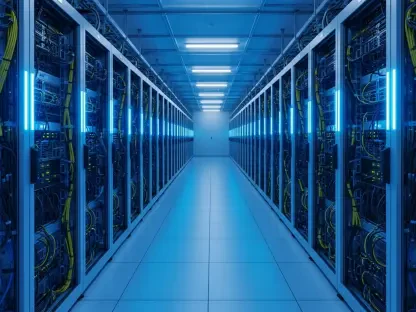Shaking the Foundations: A Market Under Scrutiny
Imagine a market so dynamic that a single company’s stumble can reverberate across an entire industry, unsettling investors and reshaping competitive landscapes in the blink of an eye. This is the reality facing the AI infrastructure sector as CoreWeave (NASDACRWV), a prominent player in GPU-intensive cloud computing, experiences a sharp stock plunge. This dramatic downturn at the close of trading has not only dented CoreWeave’s valuation but also raised pressing questions about the stability of high-growth AI firms. This market analysis delves into the catalysts behind this decline, examines current trends in the AI infrastructure space, and offers projections on how this event might redefine investment strategies and industry dynamics. The significance of this moment lies in its potential to serve as a turning point, prompting a reevaluation of risk and reward in a sector critical to technological advancement.
Decoding Market Trends: CoreWeave’s Decline and Beyond
Immediate Catalysts: Contract Uncertainties Fuel Sell-Off
The precipitous drop in CoreWeave’s stock value stems from swirling rumors of renegotiations surrounding a pivotal contract with a major AI development partner. Such agreements are central to the company’s revenue model, and any hint of unfavorable terms has spooked investors, leading to a significant sell-off on NASDAQ. This reaction underscores a broader vulnerability in specialized AI providers, where dependence on a handful of large clients can amplify the impact of even minor disruptions. The market’s swift response highlights a critical tension: while specialization in GPU-powered services for AI training has driven CoreWeave’s growth, it also exposes the firm to concentrated risks that can erode confidence overnight.
Historical Growth Trajectory: A Rise Now Tested
CoreWeave’s journey to prominence offers context for the current turmoil. Since pivoting to AI cloud computing, the company has scaled rapidly, operating 32 data centers and managing a vast network of a quarter-million GPUs as of this year. Strategic alliances with industry heavyweights like OpenAI and Meta Platforms (NASDAMETA), coupled with acquisitions such as Core Scientific, have cemented its status as a leader in AI infrastructure. Yet, this backdrop of success makes the recent decline particularly striking, as it reveals how quickly market sentiment can shift when perceived stability falters. This juxtaposition of past triumphs and present challenges serves as a reminder of the high stakes in a sector driven by relentless innovation and lofty expectations.
Ecosystem Impact: Ripples Across Suppliers and Competitors
The effects of CoreWeave’s downturn extend well into the interconnected AI ecosystem, influencing a range of stakeholders. For NVIDIA (NASDANVDA), a primary supplier of high-end GPUs, there could be concerns about future demand if CoreWeave’s struggles signal broader pricing pressures in AI cloud services, though existing commitments may provide a temporary buffer. Clients like OpenAI and Meta face a dual scenario: potential cost savings from renegotiated terms are tempered by worries over supply chain reliability with a key infrastructure provider. Meanwhile, hyperscale competitors such as Amazon Web Services (AWS), Microsoft Azure, and Google Cloud stand poised to gain, leveraging their diversified portfolios to attract clients seeking more stable alternatives. This cascading impact illustrates the fragility of specialized players in a market dominated by intricate dependencies.
Sector-Wide Volatility: Systemic Risks in Focus
Beyond CoreWeave’s immediate plight, this event reflects deeper systemic issues within the AI infrastructure market. High-growth sectors often grapple with volatility, and the reliance on a limited pool of high-profile clients, combined with escalating costs for cutting-edge hardware, creates a precarious balance. Historical parallels to tech bubbles suggest that rapid expansion phases can lead to inevitable corrections, potentially cooling investor enthusiasm for inflated valuations in AI stocks. Moreover, regulatory attention might sharpen if such instability exposes gaps in transparency or resilience within critical supply chains. This broader perspective indicates that the market may be approaching a phase of recalibration, where unchecked optimism gives way to a more measured assessment of long-term viability.
Future Projections: Navigating the AI Infrastructure Landscape
Emerging Strategies: Diversification as a Shield
Looking ahead, trends suggest that the AI infrastructure market will pivot toward risk mitigation strategies in response to recent volatility. Multi-cloud approaches are likely to gain traction as AI developers aim to reduce dependence on single providers, fostering demand for flexible and interoperable solutions. Companies may also prioritize profitability over aggressive expansion, adjusting business models to withstand economic pressures. For CoreWeave, diversifying its client base or securing strategic partnerships could be key to restoring market confidence. These shifts signal an industry maturing under scrutiny, where adaptability will distinguish leaders from laggards in the coming years.
Technological and Economic Drivers: Shaping Tomorrow’s Market
Technological advancements, such as improvements in GPU efficiency or the rise of alternative hardware, are poised to disrupt current market dynamics, potentially lowering entry barriers for new players. Simultaneously, economic factors, including fluctuating capital costs, may push firms to optimize operational efficiency. Projections indicate that between now and 2027, investment focus could shift toward sustainable growth metrics, with greater emphasis on balanced financial health rather than speculative expansion. Regulatory changes around supply chain transparency might also emerge if policymakers view market instability as a systemic concern. These drivers collectively point to a landscape where innovation must align with fiscal prudence to ensure long-term stability.
Competitive Realignment: Opportunities Amid Uncertainty
As the market digests CoreWeave’s challenges, competitive dynamics are expected to evolve. Larger hyperscalers with robust financial backing could capitalize on this moment, offering stability and diversified services to capture market share from specialized providers facing investor skepticism. Smaller firms, meanwhile, might encounter heightened scrutiny unless they demonstrate resilience through innovative offerings or niche expertise. CoreWeave’s response—whether through reassuring financial updates or expanded partnerships—will likely serve as a benchmark for how specialized AI providers can navigate turbulence. This realignment suggests a future where differentiation and reliability become paramount competitive advantages.
Reflecting on the Analysis: Lessons and Next Steps
Looking back, CoreWeave’s stock plunge stood as a defining moment that exposed both the potential and the pitfalls of the AI infrastructure market. It revealed how swiftly investor sentiment could shift in a sector fueled by high expectations, and how interconnected dependencies amplified the impact of individual setbacks. The event also underscored the urgency for strategic adaptation in an industry at a crossroads. Moving forward, businesses are encouraged to adopt diversified revenue streams and multi-cloud strategies to buffer against client-specific risks. Investors, on the other hand, need to prioritize resilience over hype, focusing on firms with sustainable growth indicators. For industry leaders like CoreWeave, transparent communication and proactive partnerships offer a path to rebuild trust. These actionable steps provide a roadmap for stakeholders to transform uncertainty into a foundation for enduring success in a rapidly evolving market.









